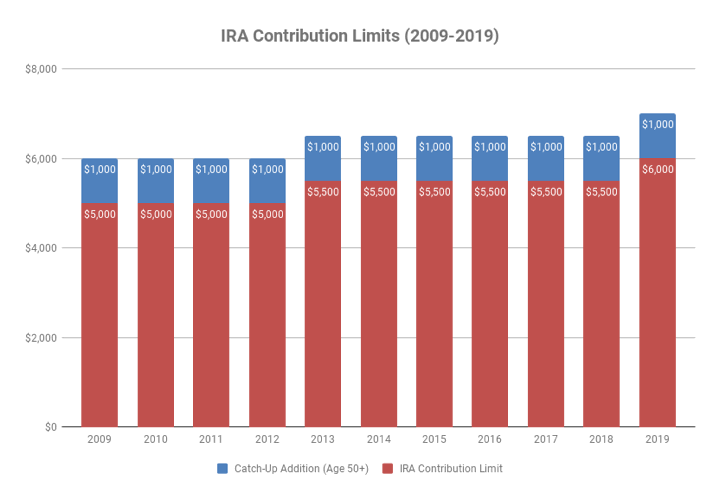 Individual Retirement Arrangements (IRAs) are way to save money towards retirement that also saves on taxes. For 2019, the annual contribution limit for either Traditional or Roth IRAs increased to $6,000 (it is roughly indexed to inflation). The additional catch-up contribution allowed for those age 50+ stays at $1,000 (for a total of $7,000). You can’t contribute more than your taxable compensation for the year, although a spouse can contribute with no income if the other person has enough income.
Individual Retirement Arrangements (IRAs) are way to save money towards retirement that also saves on taxes. For 2019, the annual contribution limit for either Traditional or Roth IRAs increased to $6,000 (it is roughly indexed to inflation). The additional catch-up contribution allowed for those age 50+ stays at $1,000 (for a total of $7,000). You can’t contribute more than your taxable compensation for the year, although a spouse can contribute with no income if the other person has enough income.
Historical limits. Since I enjoy visual aides, here’s an updated historical chart and table of contribution limits for the last 11 years. I’m happy to say that we’ve both done the max since 2004.

| Year | IRA Contribution Limit | Additional Catch-Up Allowed (Age 50+) |
| 2009 | $5,000 | $1,000 |
| 2010 | $5,000 | $1,000 |
| 2011 | $5,000 | $1,000 |
| 2012 | $5,000 | $1,000 |
| 2013 | $5,500 | $1,000 |
| 2014 | $5,500 | $1,000 |
| 2015 | $5,500 | $1,000 |
| 2016 | $5,500 | $1,000 |
| 2017 | $5,500 | $1,000 |
| 2018 | $5,500 | $1,000 |
| 2019 | $6,000 | $1,000 |
Traditional IRAs. If you are covered by a retirement plan at work, deductibility of your contribution to a Traditional IRA is based on your modified adjusted gross income (MAGI) and tax-filing status. See the IRS page on . However, there are no income restrictions as to who can contribute to the full contribution limit for a Traditional IRA.
Roth IRAs. It doesn’t matter if you are covered by a retirement plan at work for the Roth IRA, and contributions to a Roth are never deductible (but they aren’t taxed on upon qualified withdrawal). However, the contribution limit and overall eligibility may be capped based on your modified adjusted gross income (MAGI) and tax-filing status. See the IRS page on . But wait… high-income earners may be able to get around these income restrictions with a (non-deductible Traditional IRA + Roth conversion). Yeesh, I really wish they would simplify all this stuff.
Saver’s Credit. If your income is low enough (less than $63,000 AGI for married filing joint), the can get you back 10% to 50% of your contribution (of up to $2,000 per person) when you file your taxes.
Also see:
Sources: , [PDF]
“The editorial content here is not provided by any of the companies mentioned, and has not been reviewed, approved or otherwise endorsed by any of these entities. Opinions expressed here are the author’s alone.”
from .
Copyright © 2018 MyMoneyBlog.com. All Rights Reserved. Do not re-syndicate without permission.